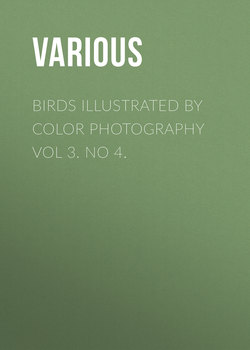Читать книгу Birds Illustrated by Color Photography Vol 3. No 4. - Various - Страница 4
THE OVENBIRD
ОглавлениеNOW and then an observer has the somewhat rare pleasure of seeing this Warbler (a trifle smaller than the English Sparrow) as he scratches away, fowl fashion, for his food. He has more than one name, and is generally known as the Golden-crowned Thrush, which name, it seems to us, is an appropriate one, for by any one acquainted with the Thrush family he would at once be recognized as of the genus. He has still other names, as the Teacher, Wood Wagtail, and Golden-crowned Accentor.
This warbler is found nearly all over the United States, hence all the American readers of Birds should be able to make its personal acquaintance.
Mr. Ridgway, in "Birds of Illinois," a book which should be especially valued by the citizens of that state, has given so delightful an account of the habits of the Golden-crown, that we may be forgiven for using a part of it. He declares that it is one of the most generally distributed and numerous birds of eastern North America, that it is almost certain to be found in any piece of woodland, if not too wet, and its frequently repeated song, which, in his opinion, is not musical, or otherwise particularly attractive, but very sharp, clear, and emphatic, is often, especially during noonday in midsummer, the only bird note to be heard.
You will generally see the Ovenbird upon the ground walking gracefully over the dead leaves, or upon an old log, making occasional halts, during which its body is tilted daintily up and down. Its ordinary note, a rather faint but sharp chip, is prolonged into a chatter when one is chased by another. The usual song is very clear and penetrating, but not musical, and is well expressed by Burroughs as sounding like the words Teacher, teacher, teacher, teacher, teacher! the accent on the first syllable, and each word uttered with increased force. Mr. Burroughs adds, however, that it has a far rarer song, which it reserves for some nymph whom it meets in the air. Mounting by easy flights to the top of the tallest tree, it launches into the air with a sort of suspended, hovering flight, and bursts into a perfect ecstacy of song, rivaling the Gold Finch's in vivacity and the Linnet's in melody. Thus do observers differ. To many, no doubt, it is one of the least disagreeable of noises. Col. Goss is a very enthusiastic admirer of the song of this Warbler. Hear him: "Reader, if you wish to hear this birds' love song in its fullest power, visit the deep woods in the early summer, as the shades of night deepen and most of the diurnal birds have retired, for it is then its lively, resonant voice falls upon the air unbroken, save by the silvery flute-like song of the Wood Thrush; and if your heart does not thrill with pleasure, it is dead to harmonious sounds." What more has been said in prose of the song of the English Nightingale?
The nests of the Golden Crown are placed on the ground, usually in a depression among leaves, and hidden in a low bush, log, or overhanging roots; when in an open space roofed over, a dome-shaped structure made of leaves, strippings from plants and grasses, with entrance on the side. The eggs are from three to six, white or creamy white, glossy, spotted as a rule rather sparingly over the surface. In shape it is like a Dutch oven, hence the name of the bird.
